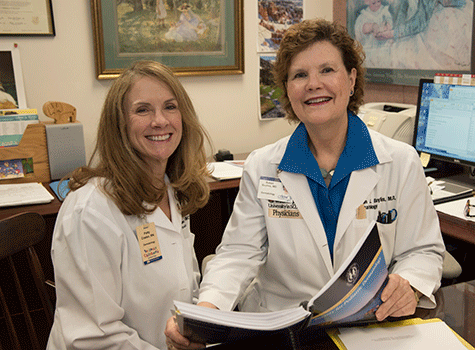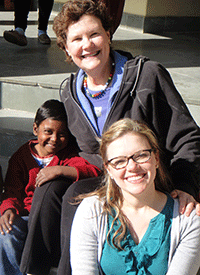
With her long, straight hair and knee-high skirt, Susan Bayliss knew she stood out. She scanned the meeting room at the University of Texas at Austin and saw young men chatting, laughing, confident and looking like they belonged.
One of only a smattering of women in the room, she was uncomfortable but determined to attend the chapter meeting for the school’s Alpha Epsilon Delta, a pre-med honor society. She had a passion for medicine and wanted to surround herself with like-minded students.
The club’s sponsor, however, made it clear she wasn’t welcome. “If you’re a girl, forget it,” his voice boomed to the group. “If you’re a girl, you’re never going to make it in medicine.”
This was during the mid-1960s, when women constituted less than 10 percent of all medical school students nationwide.
“I went home in tears,” Bayliss recalled.
Fortunately, she reached out to her father, Milward W. Bayliss, a former chief of pathology at Brooke Army Medical Center in San Antonio. His experience as an orphan during the Great Depression ingrained the importance of education, independence and perseverance.
No way was her father going to let his daughter be deterred by an ignorant comment. “That guy doesn’t know what he’s talking about,” he said. “There’s no reason you can’t be a doctor.”
Had he not been so sure of his daughter, “if he hadn’t kept encouraging me,” said Bayliss, “I might never have gone to medical school.”
Today, Bayliss, MD, is a professor of medicine and of pediatrics and director of pediatric dermatology at Washington University School of Medicine in St. Louis. Bayliss, who treats patients at St. Louis Children’s Hospital, is one of only two pediatric dermatologists in St. Louis.
She has shared her medical knowledge and talents far beyond Missouri, though, via lectures and medical missions. Additionally, she is a past president of the Society for Pediatric Dermatology and has served as an archivist for the organization for more than 20 years. The group started in 1975 with about 30 members and now boasts about 1,000 members globally.
“Dr. Bayliss is, and has always been, an enthusiastic and tireless physician, teacher, mentor and explorer of life,” said Lynn Cornelius, MD, chief of dermatology at the School of Medicine and the Winfred A. and Emma R. Showman Professor of Dermatology. “She brings so much to both dermatology and to pediatrics. Our patients are so fortunate to have her as their doctor, our residents benefit from her expertise, and our faculty appreciate the depth of her knowledge of pediatric dermatology. It is no surprise that she is nationally recognized for her talents and expertise.”
During her early days training as a doctor, Bayliss struggled to gain respect from some of her male colleagues, patients not used to women physicians and some nurses not accustomed to taking orders from female doctors.
But as more young women entered medical school — today, they make up roughly half of U.S. students — and became doctors, gender became less of an issue, Bayliss said. Her early experiences, though, helped shape her bedside manner. She is affable and playful yet sensitive to the physiological and emotional needs of her young patients, treating them with the same professionalism granted to adult patients.
“I don’t talk down to kids,” Bayliss said. “If you can talk to them like a real person, they will blossom, and they will be more motivated to take care of their health.”
Passions combined
Not surprisingly, Bayliss is almost as likely to research youth-oriented ice breakers as she is genetic skin diseases. In her office at Children’s Hospital, medical journals and data graphs mesh comfortably with children’s books, including “The Funnybone Book,” which is full of jokes she memorizes for her youngest patients.
“Here’s a good one,” she said with the same enthusiasm a child might have. “What do you get when you cross a bell with a chicken?
“An alarm cluck.”
Bayliss laughed. “I love kids,” she said.
She has two of her own — Elizabeth and Meredith, now grown and married. She also has two grandsons, Cai, 9, and Eli, 8.

One look around her office and grandma pride is evident: Mingling with the research articles and patient files on her desk is a prominently displayed Lego creation of the Krusty Krab from “SpongeBob SquarePants.” Her grandsons built the set for her because the three of them love Legos and SpongeBob.
Photographs of her grandsons decorate her office. There they are frolicking in their blue and green pajamas; there they are playing their dad’s guitar; there they are smiling in their home in Germany, where their father is stationed in the U.S. Air Force.
Bayliss also displays photographs of children she has helped from around the world, including a 7-year-old girl she met in January 2013, when she was on a medical mission in northern India. She gave general physicals to 400 kids who had never been to a doctor, diagnosing and treating common ailments such as ear infections and anemia along with serious conditions like leprosy — a chronic bacterial infection that causes unsightly skin sores, nerve damage and muscle weakness.
In northern India, Bayliss said, people with leprosy are shunned to the outskirts of society and forced to beg for food. But it needn’t be, she said, because leprosy is treatable by taking antibiotics for a year.
Even if a skin condition is not as visually startling as leprosy, Bayliss said many patients feel self-conscious with common ailments such as acne, eczema, hair loss, unusual moles and birthmarks. Treating the condition produces physiological and visual results, which can boost confidence.
“You don’t appreciate your skin until something goes awry,” she said.
Team leader
Among Bayliss’ areas of focus, she heads a team of 11 interdisciplinary physicians at Washington University in the Vascular Anomalies Clinic, which addresses vascular malformations, complicated hemangiomas and vascular birthmarks.

Her clinical research has involved genetic skin diseases, and education also has been an important part of her job since many skin conditions can be prevented with a little self-care. For instance, Bayliss tells her tween and teen patients that eating healthy, exercise and daily face-washing with mild soap can go a long way in fighting acne.
Most important, however, is reducing the risk for melanoma, a potentially fatal skin cancer with increasing rates in teens and people in their 20s, partly due to tanning beds. “I believe tanning beds should be banned,” Bayliss said. “There is no safe level of ultraviolet radiation. There is nothing good about tanning beds,” including ones that advertise safer and newer technology.
Sunscreen use can significantly reduce a person’s skin-cancer risk, Bayliss stresses to her patients. She cites research that showed a drastic decrease in melanoma rates in Australia after schools required students to wear sunscreen, hats and full-length swim shirts.
“If you see me at the beach, this is what I’ll look like,” Bayliss said, pointing to a photograph in her office that shows her lounging in a chair in the sand, sitting under an umbrella, donning a hat and covered in a long-sleeved, ankle-length wetsuit.
“I might get a lot of stares,” Bayliss said, laughing, “but I’m trying to bring this look back in style.”
Other items in her office also prompt visitors to do double-takes: the photo of a young Bayliss with the bright yellow Mustang her dad gave her as a graduation gift, and pictures of Bayliss as an Army child, moving from Texas to California to Japan, “where people stared because they weren’t used to seeing kids with blonde hair and blue eyes in the ‘50s, after the war.”
Her office also boasts an Elvis clock in which the King’s legs move back and forth like he’s dancing. Her desk features figurines and other artifacts collected from her travels to 70 countries on six continents, as well as all 50 states in the U.S. The top of a bookcase displays her collection of the blue Genie character from Disney’s “Aladdin.” She likes the character because actor Robin Williams provided Genie’s voice in the animated movie. “I love Robin Williams because he is hilarious and spontaneous,” Bayliss said.
The photographs and mementos honor not only her passions and personality but also the professional challenges she has mastered. “I’m a very visual person,” Bayliss said. “That’s one of the reasons why I love dermatology. I have the best job ever.”